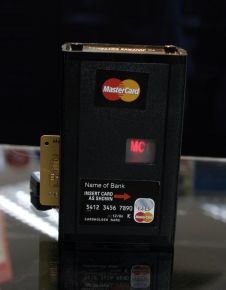MasterCard unveils stealth protection

Dubbed the Hidden Image Reader, the device is used to read a "hidden image"--which is invisible to the naked eye--embedded in the hologram found on the front of all MasterCard's credit and debit cards.
 MasterCard's Hidden Image Reader |
Touted as the first in Southeast Asia for the credit card giant, the card reader can only be used to scan MasterCard cards and costs between US$175 to US$200, according to MasterCard.
The special reader will be deployed for use across all outlets under Japanese electronics retail chain Best Denki, in a three month-long pilot program, in Singapore. According to OCBC, the bank will assess the situation and monitor the fraud rate, before deciding whether to continue the program.
To determine if a MasterCard plastic is a genuine or counterfeit, users have to insert the card into the reader, and a laser beam will read a specific part of the hologram to reveal the appropriate image.
Existing genuine MasterCard cards in circulation have the images--"MC1" or "ABNH"--hidden within the hologram, which will appear on the red color display located on the top of the reader, according to the company.
Counterfeit cards will not reveal any image.
According to Barry Wong, MasterCard's Asia-Pacific senior business leader of security and risk services, the hidden image cannot be duplicated and is also not subjected to wear and tear.
Wong said that Singapore is the second country in Asia, after Japan, to have launched this initiative. MasterCard first unveiled the reader in a pilot program in Japan last year--held from March to August--carried out by six "high risk" merchants, including jewelry and electronics retailers. ZDNet Asia understands that the program has since ended. According to MasterCard's Japan office, feedback from customers involved in the pilot program indicated that users were not willing to put up with the additional waiting time to have their cards processed.
Last week, Citibank launched a new biometric payment service that lets its credit card customers pay for goods and services with their fingerprint, to provide added protection against card fraud.